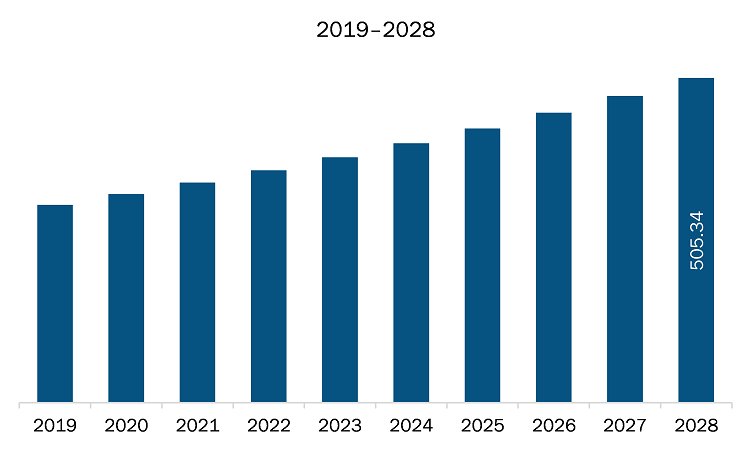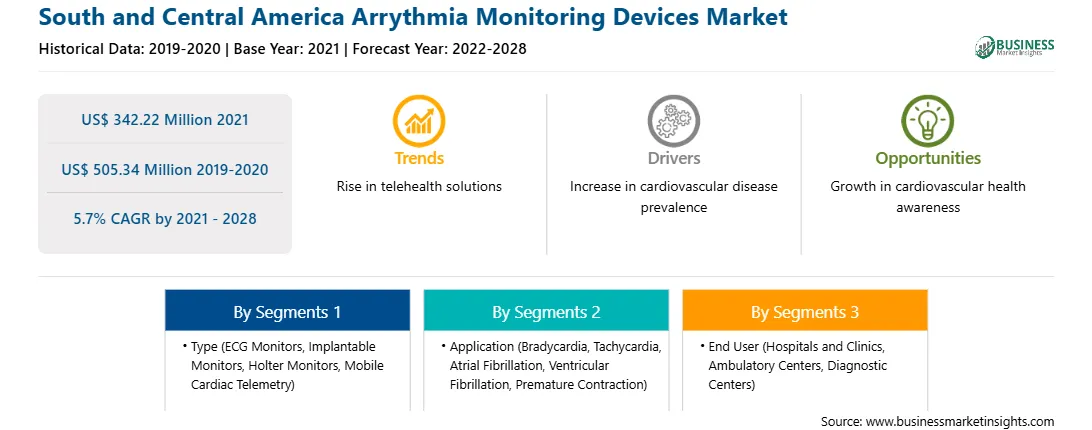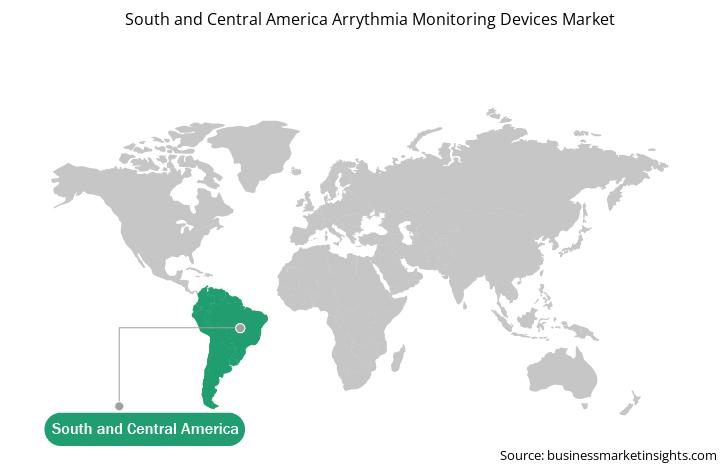South and Central America (SCAM) region consists of Brazil, Argentina, and rest of South and Central America. The countries are likely to offer growth opportunities due to presence of well-developed and established healthcare industries, increasing support from governments, and rising research and developments. Brazil is the fifth largest country in the world, both by area and by population, and experiencing the fastest demographic aging worldwide. In Brazil, the aging population is at a rapid pace and in a context of regional and historical socioeconomic inequalities. According to the study conducted in Brazil, the community of women estimated at the vast majority with 16.9 million (56%) of elderly persons, whereas older adults estimated approx. 13.3 million (44%). The growing aging population leads to an increased incidence of cardiovascular disease. Such growing conditions are likely to drive the adoption of medical devices, which will eventually drive the Brazil arrhythmia monitoring devices market during the forecast period. According to the World Health Organization (WHO), approximately 28% of the total deaths in 2016 were contributed by cardiovascular diseases. Factors contributing to an increase in cardiovascular diseases are the increasing prevalence of smoking, obesity, and hypertension. According to the World Health Organization (WHO), in 2016, 22% of the Brazilian population was obese, 14% of the population was engaged in smoking tobacco, and 23% had hypertension. This is further likely to induce the growth of the market in Brazil during the coming years
The arrhythmia monitoring devices market in the South and Central America includes the Brazil, Argentina, and other South American countries. The South America has reported 31.8 million cases as of June 23, 2021. The number of growing COVID-19 cases has been reported, such as, Brazil (18,056,639), Argentina (4,298,782), Columbia (3,997,021), and Chile (1,525,663). Considerable number of countries in South America have very underdeveloped healthcare infrastructure. In addition, the availability of arrhythmia monitoring in the region is also significantly lower. For instance, Peru, has less than 1000 intensive care unit beds for its 32 million inhabitants. Furthermore, supply chain disruption caused due to congestion of ports and disturbances in other transport means had substantial impact on the distribution of arrhythmia monitoring and other associated devices in the region. All these factors considerably deterred the growth of South and Central America arrhythmia monitoring devices market.

Strategic insights for the South and Central America Arrythmia Monitoring Devices provides data-driven analysis of the industry landscape, including current trends, key players, and regional nuances. These insights offer actionable recommendations, enabling readers to differentiate themselves from competitors by identifying untapped segments or developing unique value propositions. Leveraging data analytics, these insights help industry players anticipate the market shifts, whether investors, manufacturers, or other stakeholders. A future-oriented perspective is essential, helping stakeholders anticipate market shifts and position themselves for long-term success in this dynamic region. Ultimately, effective strategic insights empower readers to make informed decisions that drive profitability and achieve their business objectives within the market.

| Report Attribute | Details |
|---|---|
| Market size in 2021 | US$ 342.22 Million |
| Market Size by 2028 | US$ 505.34 Million |
| Global CAGR (2021 - 2028) | 5.7% |
| Historical Data | 2019-2020 |
| Forecast period | 2022-2028 |
| Segments Covered |
By Type
|
| Regions and Countries Covered | South and Central America
|
| Market leaders and key company profiles |
The geographic scope of the South and Central America Arrythmia Monitoring Devices refers to the specific areas in which a business operates and competes. Understanding local distinctions, such as diverse consumer preferences (e.g., demand for specific plug types or battery backup durations), varying economic conditions, and regulatory environments, is crucial for tailoring strategies to specific markets. Businesses can expand their reach by identifying underserved areas or adapting their offerings to meet local demands. A clear market focus allows for more effective resource allocation, targeted marketing campaigns, and better positioning against local competitors, ultimately driving growth in those targeted areas.

The arrythmia monitoring devices market in SCAM is expected to grow from US$ 342.22 million in 2021 to US$ 505.34 million by 2028; it is estimated to grow at a CAGR of 5.7% from 2021 to 2028. Market consolidations, Changes or shift in technology-related trends encourage players to develop innovative devices. Recent developments in HIPPA-compliant technology have enabled secured data transmission throughout the monitoring period without delays. Emerging technologies are providing effective alternatives for traditional Holter monitors that create alerts for patients with a high risk of cardiac arrhythmia. Hence, continuous remote monitoring capabilities of these devices facilitating long-term, uninterrupted cardiac rhythm management are adding to their popularity. The mobile cardiac telemetry (MCT) system is an innovative product that assist in monitoring heart conditions of cardiac patients. Patients carry the tiny sensor and monitor throughout the day, and whenever, a cardiac event occurs, MCT sends the data to a central system for analysis and reaction. The system generates a report and shares it with the patient's physician, along with graphs and trends, for further actions. The abilities of MCT systems to analyze every heartbeat with little interference to the patient's normal days and to initiate an immediate emergency response as needed make them one of the most attractive choices cardiac monitoring. This is bolstering the growth of the arrythmia monitoring devices market.
In terms of type, the holter monitors segment accounted for the largest share of the SCAM arrythmia monitoring devices market in 2020. In terms of application, the atrial fibrillation segment held a larger market share of the arrythmia monitoring devices market in 2020. Further, the hospitals and clinics segment held a larger share of the market based on end user in 2020.
A few major primary and secondary sources referred to for preparing this report on arrythmia monitoring devices market in SCAM are company websites, annual reports, financial reports, national government documents, and statistical database, among others. Major companies listed in the report are Abbott; Biotronik, Inc.; General Electric Company; Hill-Rom Holding Inc.; Koninklijke Philips N.V.; Medtronic
The South and Central America Arrythmia Monitoring Devices Market is valued at US$ 342.22 Million in 2021, it is projected to reach US$ 505.34 Million by 2028.
As per our report South and Central America Arrythmia Monitoring Devices Market, the market size is valued at US$ 342.22 Million in 2021, projecting it to reach US$ 505.34 Million by 2028. This translates to a CAGR of approximately 5.7% during the forecast period.
The South and Central America Arrythmia Monitoring Devices Market report typically cover these key segments-
The historic period, base year, and forecast period can vary slightly depending on the specific market research report. However, for the South and Central America Arrythmia Monitoring Devices Market report:
The South and Central America Arrythmia Monitoring Devices Market is populated by several key players, each contributing to its growth and innovation. Some of the major players include:
The South and Central America Arrythmia Monitoring Devices Market report is valuable for diverse stakeholders, including:
Essentially, anyone involved in or considering involvement in the South and Central America Arrythmia Monitoring Devices Market value chain can benefit from the information contained in a comprehensive market report.